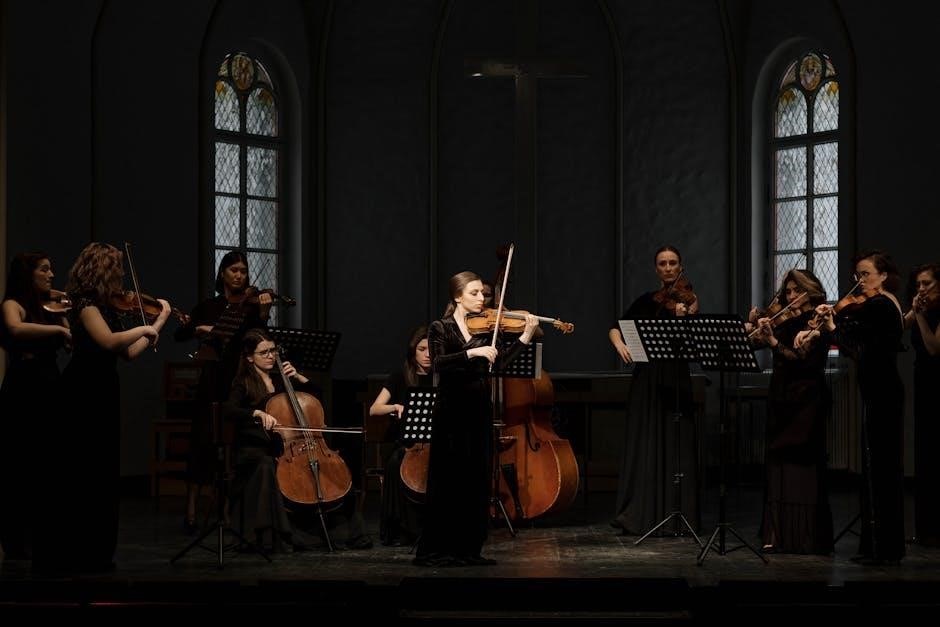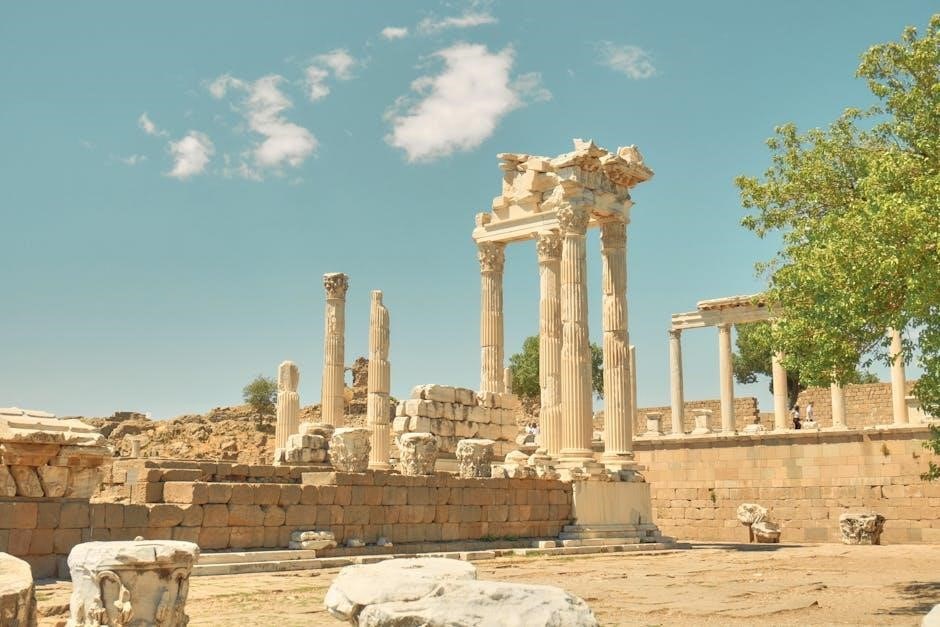
theater guide crossword clue
The Theater Guide crossword clue is a popular puzzle question that challenges solvers to identify key figures or items in a theater setting. Common answers include USHER, PLAYBILL, and AISLELIGHT, each representing different aspects of theater operations. This clue not only tests knowledge of theater terminology but also offers a fun way to engage with the world of performing arts, making it a favorite among crossword enthusiasts.

USHER
The USHER is a key figure in theaters, responsible for guiding patrons to their seats and maintaining order during performances. This role is often associated with the Theater Guide crossword clue, highlighting their essential function in ensuring a smooth theater experience.
2.1 Role in the Theater
The USHER plays a crucial role in the theater, ensuring a seamless experience for patrons. Their primary responsibilities include seating guests, distributing playbills, and maintaining order. They also assist with emergency evacuations, making them vital for safety. This role is often linked to the Theater Guide crossword clue, emphasizing their importance in theater operations. Their visibility and interaction with audiences make them a key figure in the overall theater experience.
2.2 Etymology and History
The term USHER originates from the Old French word huissier, meaning “doorkeeper,” reflecting the role’s historical roots in managing access to exclusive spaces. In theaters, the position has evolved from its origins in medieval Europe, where ushers controlled entry to royal courts and ceremonial events. Over time, the role became integral to theater operations, ensuring orderly audience movement and maintaining decorum. Historically, ushers were also responsible for lighting, such as extinguishing candles or adjusting gaslights, before modern lighting systems emerged. The role has retained its essence, adapting to technological advancements while remaining a cornerstone of theater etiquette. Today, the USHER is a familiar figure, often associated with the Theater Guide crossword clue, symbolizing their enduring importance in the theater experience.
2.3 Cultural Significance
The role of the USHER holds significant cultural importance, as it embodies the traditions of theater etiquette and audience experience. Often seen as the first point of contact for patrons, ushers create a welcoming atmosphere, setting the tone for the performance. Their presence is deeply rooted in the history of theater, where they have long been responsible for guiding audiences and maintaining order. In modern times, the usher has become a symbol of professionalism and respect for the arts. Beyond their practical duties, ushers are often celebrated in media and literature as figures who bridge the gap between the audience and the stage. Their role is not just functional but also ceremonial, contributing to the overall sense of occasion in live performances. This cultural significance is reflected in their prominence as a common answer to the Theater Guide crossword clue, highlighting their enduring relevance in the world of theater.

PLAYBILL
The PLAYBILL is a program provided to theater audiences, detailing the cast, crew, and production information. It serves as a guide, enhancing the audience’s understanding and appreciation of the performance, making it an essential theater companion.

3.1 Definition and Purpose
A PLAYBILL is a printed or digital program distributed at theatrical performances, providing essential details about the production. It typically includes the cast list, crew credits, synopsis, and acknowledgments. The primary purpose of a PLAYBILL is to inform and engage the audience, offering insights into the story, characters, and creative team behind the performance. Additionally, it often features advertisements, making it a vital resource for both patrons and the theater community. The PLAYBILL serves as a keepsake, allowing audiences to remember the experience long after the curtain falls. Its definition and purpose are deeply rooted in enhancing the overall theater experience, making it a cornerstone of live performances.

3.2 Historical Background
The PLAYBILL has a rich history dating back to the 19th century, originating as a simple broadside distributed at theaters to announce performances. Over time, it evolved into a detailed program, incorporating cast lists, synopses, and advertisements. Initially, PLAYBILLs were basic, focusing on essential information, but by the 20th century, they became more elaborate, featuring artwork, biographies, and behind-the-scenes insights. The rise of digital technology in the 21st century led to the development of digital PLAYBILLs, enhancing accessibility while retaining their traditional charm. Despite these changes, the core purpose of the PLAYBILL remains unchanged: to inform, engage, and enrich the audience’s experience. Its historical evolution reflects the dynamic nature of theater itself, adapting to technological advancements while preserving its role as a cherished keepsake for theatergoers.
3.3 Modern Usage
In contemporary theaters, the PLAYBILL remains a vital component of the audience experience, blending tradition with modern innovations. Today, many theaters offer digital versions of the PLAYBILL, accessible via mobile apps or websites, allowing patrons to view the program before or during the performance. This shift to digital formats enhances accessibility and reduces environmental impact. Additionally, modern PLAYBILLs often include interactive features, such as interviews with cast members, behind-the-scenes insights, and links to related content. Despite the rise of digital alternatives, printed PLAYBILLs continue to be cherished as collectibles, particularly for significant productions. Theaters also use data from digital engagement to better understand audience preferences and tailor future programming. This evolution ensures the PLAYBILL remains relevant, adapting to changing times while maintaining its core purpose of enriching the theater experience for audiences worldwide.

AISLELIGHT
AISLELIGHT refers to the lighting installed along theater aisles, ensuring visibility during performances. It is crucial for patron safety and ease of movement, often dimmed during shows to maintain the theatrical atmosphere while remaining functional.
4.1 Function in Theaters
AISLELIGHT serves a critical role in theaters by providing illumination along aisles and walkways. Its primary function is to ensure patron safety, preventing accidents during movements to and from seats, especially in low-light conditions. This lighting is typically subtle, designed to guide audience members without disrupting the performance atmosphere. It also aids ushers in efficiently directing patrons and maintaining order. Additionally, aisle lights often dim or brighten in sync with the show’s lighting cues, enhancing the overall theatrical experience while fulfilling practical needs. Their presence is essential for smooth operations, balancing both functionality and aesthetic considerations in a theater setting.
4.2 Evolution Over Time
The concept of AISLELIGHT has evolved significantly over the years, adapting to advancements in technology and changing theater needs. Originally, aisle lighting was simple, using basic lamps or candles to guide audiences. In the 19th century, gas lighting became common, providing brighter illumination. The 20th century saw the introduction of electric lighting, which improved safety and visibility. Modern theaters now utilize LED-based aisle lights, offering energy efficiency and customizable brightness. These lights are often integrated with smart systems, allowing them to dim or brighten automatically during performances. The evolution of aisle lighting reflects broader technological progress, ensuring safer and more immersive theater experiences. From humble beginnings to sophisticated designs, aisle lights remain a vital component of theater operations, blending functionality with aesthetics to enhance patron safety and enjoyment.
4.3 Safety Importance
Aisle lights play a critical role in ensuring patron safety within theaters. These lights are designed to illuminate walkways and stairs, reducing the risk of accidents, especially during performances when the main house lights are dimmed. Properly lit aisles help guide audience members to their seats and emergency exits, minimizing the likelihood of trips or falls. In emergency situations, such as evacuations, aisle lights provide clear visibility, allowing patrons to exit safely and efficiently. Many theaters are required to meet specific safety regulations, and aisle lighting is a key component of these standards. Modern systems often include backup power sources to ensure continuous illumination during power outages. By maintaining visibility and ensuring clear pathways, aisle lights are essential for creating a secure environment in theaters, prioritizing both patron safety and comfort. Their role extends beyond functionality, contributing to an overall positive theater experience.

How to Solve Theater Guide Crossword Clues
Solving theater guide crossword clues requires a combination of knowledge about theater terminology and effective puzzle-solving strategies. Start by carefully reading the clue to understand its context and any hints it provides. For example, if the clue is “Theater guide,” possible answers like USHER or PLAYBILL come to mind, as these are common terms associated with guiding or informing patrons in a theater setting.
Next, consider the length of the answer and the letters already filled in the puzzle grid. This can help narrow down possibilities. If the clue refers to a specific role or item, think about synonyms or related terms. For instance, AISLELIGHT is a term tied to safety and navigation in theaters, making it a strong candidate for clues related to lighting or guidance.
Use crossword solvers or dictionaries to verify potential answers, especially if you’re stuck. Cross-referencing clues in the puzzle can also provide additional insights. Practice and familiarity with theater-related terms will enhance your ability to solve these clues efficiently. Over time, you’ll develop a keen sense of recognizing patterns and connections, making you a skilled solver of theater-themed crosswords.

Common Crossword Clues Related to Theater Guides
Several crossword clues are frequently associated with theater guides, each pointing to specific roles or items within a theater setting. Common clues include:
- USHER: A person who guides patrons to their seats and maintains order in the theater.
- PLAYBILL: A program or pamphlet detailing the performance, cast, and crew.
- AISLELIGHT: Lights that illuminate walkways for safety and navigation.
Other related clues might include “Theater employee,” “Program offerer,” or “Safety light,” all of which connect to essential aspects of theater operations. These clues test solvers’ knowledge of theater terminology and their ability to link terms to their functions. By recognizing these patterns, enthusiasts can improve their crossword-solving skills in theater-themed puzzles.

Tips for Mastering Theater-Themed Crosswords
Mastery of theater-themed crosswords requires a blend of knowledge and strategy. First, familiarize yourself with common theater terminology, such as roles like USHER or items like PLAYBILL; Recognizing these terms can help you quickly fill in clues. Next, practice regularly to build a mental database of theater-related words and their meanings. Pay attention to clue patterns, such as word lengths and letter sequences, which can narrow down possible answers. Additionally, use online resources or crossword solvers to verify answers and expand your vocabulary. Finally, stay patient and persistent, as improving at crosswords takes time. By combining these approaches, you can enhance your skills and enjoy tackling theater-themed puzzles with confidence.

Resources for Theater Guide Crossword Enthusiasts
For those passionate about solving theater-themed crosswords, several resources can aid in mastering the Theater Guide clue and similar puzzles. Online crossword solvers, such as Crossword Solver and Crossword Clue Solver, provide comprehensive databases of clues and answers, including those related to theater terminology. Additionally, websites like crosswordsolver.com offer detailed lists of possible answers for clues like Theater Guide, making them invaluable for both beginners and experienced solvers. Many official theater websites also feature glossaries or FAQs that define key terms, such as USHER or PLAYBILL, which can enhance your understanding and improve your crossword skills. Furthermore, joining crossword communities or forums can connect you with other enthusiasts, allowing you to share tips and strategies for tackling theater-themed puzzles effectively. By utilizing these resources, crossword enthusiasts can expand their knowledge and enjoy a more rewarding puzzle-solving experience.
The Theater Guide crossword clue offers a fascinating glimpse into the world of theater terminology, challenging solvers to think creatively about key roles and items. Common answers like USHER, PLAYBILL, and AISLELIGHT highlight essential aspects of theater operations, from guiding patrons to providing programs and ensuring safety. These clues not only test knowledge but also encourage a deeper appreciation for the theatrical experience. For enthusiasts, resources like crosswordsolver.com and theater websites provide valuable tools to enhance skills and explore more puzzles. Whether you’re a casual solver or a dedicated crossword fan, the Theater Guide clue and its related questions offer a rewarding and engaging challenge. Embrace the opportunity to expand your knowledge and enjoy the thrill of uncovering the next answer in your theater-themed crossword journey!